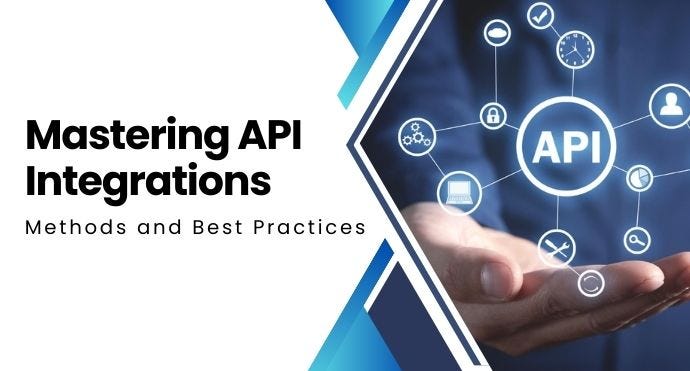Mastering API Integrations: Methods and Best Practices

In today’s interconnected digital landscape, the seamless exchange of data between applications is crucial for businesses to thrive. Application Programming Interfaces (APIs) serve as the backbone of this data exchange, enabling different software systems to communicate and work together. However, mastering API integrations requires a clear understanding of methods and best practices to ensure smooth operations, data security, and scalability. In this blog, we’ll explore the key aspects of API integration and provide insights into best practices to help you succeed in this critical area of modern software development.
Understanding API Integrations
Before diving into the methods and best practices, let’s first clarify what API integrations are and why they matter
API (Application Programming Interface): It’s a set of rules and protocols that allows different software applications to communicate and interact with each other. APIs define the methods and data formats that applications can use to request and exchange information.
API Integration: It’s the process of connecting two or more software systems via their APIs to enable them to work together and share data seamlessly. This can involve retrieving data from an external service, sending data to it, or performing various operations between systems.
Methods for API Integration
When integrating APIs, there are several methods to consider, each with its own advantages and use cases. Here are some common methods:
1. RESTful APIs: Representational State Transfer (REST) is an architectural style for designing networked applications. RESTful APIs use HTTP methods (GET, POST, PUT, DELETE) to perform CRUD (Create, Read, Update, Delete) operations on resources. They are widely used due to their simplicity and scalability.
2. SOAP APIs: Simple Object Access Protocol (SOAP) is a protocol for exchanging structured information in web services using XML. SOAP APIs are known for their strict standards and are often used in enterprise-level integrations.
3. GraphQL: GraphQL is a query language and runtime for APIs that allows clients to request only the data they need, reducing over-fetching and under-fetching of data. It provides a more flexible and efficient way to query data.
4. Webhooks: Webhooks allow applications to receive real-time notifications from external services when specific events occur. They are commonly used for event-driven integrations, such as processing payments or updating inventory.
5. RPC (Remote Procedure Call): RPC APIs enable one program to call a function or method in another program running on a remote server. gRPC, a high-performance RPC framework, is gaining popularity in microservices architectures.
Best Practices for Successful API Integrations
Now that we’ve covered the methods, let’s explore best practices to ensure your API integrations are robust and reliable:
1. Documentation: Always start with thorough documentation. Both the API provider and consumer should have clear and up-to-date documentation detailing endpoints, request parameters, response formats, and authentication methods.
2. Authentication and Security: Implement robust authentication mechanisms such as API keys, OAuth, or JWT tokens to secure API access. Use HTTPS to encrypt data transmission. Keep sensitive data, like API keys, secure.
3. Rate Limiting: To prevent abuse and ensure fair usage, enforce rate limiting on API endpoints. This helps maintain the quality of service for all consumers.
4. Error Handling: Plan for graceful error handling and provide meaningful error messages in your API responses. This helps developers troubleshoot issues effectively.
5. Testing: Rigorously test your API integrations, including error scenarios and edge cases, before deploying them in a production environment. Use mocking for external APIs during testing to avoid unnecessary external calls.
6. Monitoring and Logging: Implement monitoring tools to track API performance and usage. Set up logging to record important events, errors, and exceptions for later analysis.
7. Versioning: When making changes to your API, use versioning to ensure backward compatibility with existing consumers. This prevents breaking changes from affecting users of older API versions.
8. Caching: Implement caching for frequently accessed data to reduce the load on both your system and the API provider’s system. Use cache-invalidation mechanisms to keep data up to date.
9. Scalability: Design your integration with scalability in mind. Consider using load balancers, distributed systems, and asynchronous processing to handle increased traffic.
10. Maintenance and Updates: Regularly review and update your integrations to accommodate changes in the API provider’s offerings. Stay informed about deprecations and migrations to newer API versions.
11. Documentation and Communication: Keep communication channels open with the API provider’s support team. Being proactive in seeking assistance can help resolve issues faster.
Conclusion
Mastering API integrations is an essential skill for modern software development. By understanding the methods available and adhering to best practices, you can ensure that your integrations are reliable, secure, and scalable. Whether you’re building applications, connecting services, or managing data flow, effective API integration is key to delivering a seamless user experience and staying competitive in today’s digital landscape.

Comments
Post a Comment